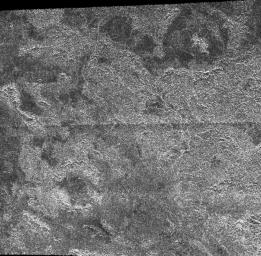
|
Impact Craters on Xanadu
- Click the image above for a larger view
- Full-Res JPEG (1477 x 1448) (786.5 kB)
- Full-Res TIFF (1477 x 1448) (2.1 MB)
Caption:
This image from the Synthetic Aperture Radar instrument on the Cassini spacecraft shows the radar-bright region Xanadu and two circular features interpreted to be degraded impact craters. In radar images, bright regions indicate a rough or scattering material, while a dark region might be smoother or more absorbing. The image was acquired during a flyby of Titan on April 30, 2006.
Near the top of the image is a 70-kilometer-wide (47-mile-wide) impact structure. In contrast to a similarly sized crater called Sinlap (see PIA07368 ), this crater shows a prominent central peak, indicating that the interaction between the impact and the crust was different in this region.
Near the bottom of the image is another circular feature with a dark central region that does not show evidence of a central peak. Numerous radar-bright channels cut across the image, indicating that liquids have flowed in this region.
Background Info:
The Cassini-Huygens mission is a cooperative project of NASA, the European Space Agency and the Italian Space Agency. The Jet Propulsion Laboratory, a division of the California Institute of Technology in Pasadena, manages the mission for NASA's Science Mission Directorate, Washington, D.C. The Cassini orbiter was designed, developed and assembled at JPL. The radar instrument was built by JPL and the Italian Space Agency, working with team members from the United States and several European countries.
For more information about the Cassini-Huygens mission visit http://saturn.jpl.nasa.gov/home/index.cfm .
Cataloging Keywords:
| Name | Value | Additional Values |
|---|---|---|
| Target | Titan | |
| System | Saturn | |
| Target Type | Satellite | |
| Mission | Cassini-Huygens | |
| Instrument Host | Cassini Orbiter | |
| Host Type | Orbiter | |
| Instrument | Radar Mapper | |
| Detector | ||
| Extra Keywords | Crater, Grayscale, Impact, Radar | |
| Acquisition Date | ||
| Release Date | 2006-05-05 | |
| Date in Caption | 2006-04-30 | |
| Image Credit | NASA/JPL-Caltech/ASI | |
| Source | photojournal.jpl.nasa.gov/catalog/PIA08429 | |
| Identifier | PIA08429 | |
